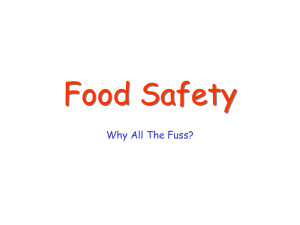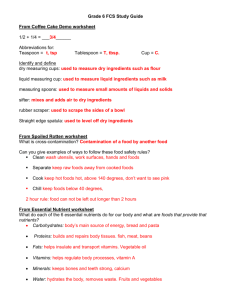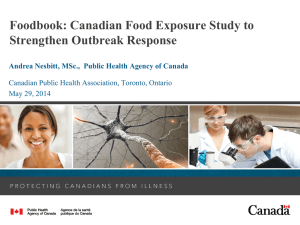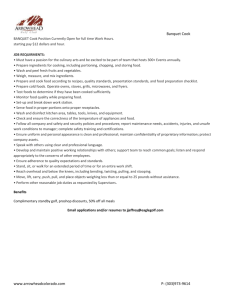the presentation. - Massachusetts Farm to School
advertisement
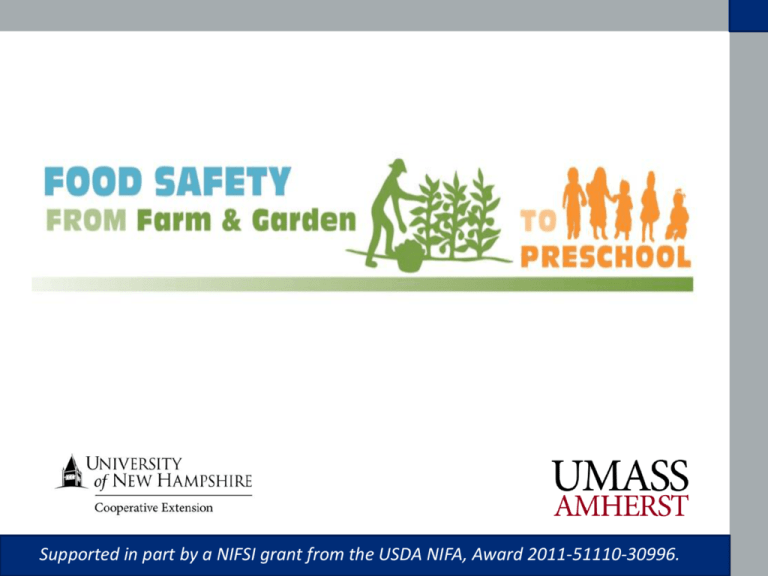
Supported in part by a NIFSI grant from the USDA NIFA, Award 2011-51110-30996. Program Goal • We want children to learn about how food is grown and where it comes from by supporting local agriculture. • We want young children to eat more fruits and vegetables and develop lifelong, healthy eating habits. • We want to help protect the health and well-being of the young children in your care. Overview • Benefits of incorporating farm to preschool programs • Fresh Produce and risk of foodborne illness • Food safety for the kitchen and classroom – 4 key food safety messages Fruits and Vegetables • Recommendations for preschoolers – 1 to 1.5 cups of fruit – 1 to 2 cups of vegetables • Make half your plate fruits and vegetables Fruits and Vegetables • Do most preschoolers eat the recommended amount of fruits and vegetables? • How many exposures needed to overcome fear? 1. 2. 3. 4. 3 to 5 4 to 8 5 to 10 6 to 12 Farm to Preschool Activities What farm to preschool activities do you implement at your school? Best Practices for Implementing Farm to School 1. Incorporate local produce into meals and snacks 2. Plant a garden at your school 3. Provide hands-on nutrition education centered on fruits, vegetables and food safety practices Best Practices 4. Plan a field trip to a farm 5. Take the children to a farmers’ market 6. Hold a harvest festival 7. Invite a farmer to visit your classroom Fresh Produce and Foodborne Illness Risks • Define foodborne illness • Why are young children at greater risk for a foodborne illness? • Which foods pose the greatest risk for children? Foodborne Illness Defined • Foodborne Illness – Illness caused by eating food that is contaminated • Three types of contaminants: – Chemical – cleaners, pesticides – Physical – glass, wood, bandages, fingernails – Biological – bacteria, viruses, parasites, fungi • Pathogens Young Children at Greater Risk • Young children are at increased risk for foodborne illness: – Immune system is not fully developed – Less stomach acid – Weigh less, limited control over diet • Small amounts of some pathogens can cause illness Fresh Produce and Foodborne Illness Risk • Fresh produce – can be a source of foodborne illness • Fresh produce was vehicle for 46% of all foodborne illnesses from 1998-2008 • Produce linked to 38% of hospitalizations, 23% of deaths Produce Outbreaks by Item, 1998-2008 Source: FDA 2009 Fresh Produce and Contamination • At risk for cross-contamination: – On farm – animal feces, water, soil, other foods – In transit – with raw meats or meat products – At your center – unwashed hands, equipment • How you purchase, store, handle, and prepare fresh produce is important Purchasing Fresh Produce • Meet local and state standards: – Certification by local or state health department – Compliance with local, state, federal regulations – Evidence of food safety plans, for example, Good Agricultural Practices (GAP) or Commonwealth Quality in MA – Access to food safety inspection reports Handling Fresh Produce • Remove visible soil • Wash fruits and vegetables in cool, running water • Wash between leaves and stems • Remove bruised or damaged areas • Refrigerate cut melons, cut tomatoes and cut leafy greens • Store above and away from other foods that can drip on produce • Keep refrigerator at 41° F or colder High Risk Foods • • • • • Unpasteurized juices and cider Raw milk and cheese Raw egg products Raw meats, poultry, fish Bean sprouts – do not serve to young children Best Practices • Purchase fresh produce from approved sources • Follow recommended food safety practices: – Select produce without bruises, holes, torn skin – Wash produce in potable/drinkable, running water – even those that are peeled – Store produce away from raw meat/poultry – Do not serve high risk foods – unpasteurized juices and cider, raw cheese, milk, eggs, meat – Do not grow or serve bean sprouts Food Safety in the Kitchen and Classroom • Clean – Wash hands, surfaces, equipment, fruits and vegetables • Separate – Keep raw and ready-to-eat foods separate. • Chill – Keep cold foods cold. • Cook – Keep hot foods hot. Clean • When to wash your hands: – Before eating, handling or preparing food – Before touching ready-to-eat foods – After touching raw or undercooked meat, fish, poultry, eggs – After using the restroom – After touching animals or working in the garden Handwashing • Wet hands with warm water • Apply soap • Rub hands / arms 20 seconds Clean under nails, between fingers • Rinse with warm water • Dry hands with paper towel or air dryer Clean • Keep surfaces and equipment clean and sanitized – Counters, microwave plates, desks, tables • Remove visible soil with hot, soapy water, rinse with clean water • Once clean, sanitize • 1 tablespoon bleach/ 1 gallon water • Air dry Clean • Washing fresh produce – even foods you peel – Remove outer leaves – Wash in running tap water – Rub leaves and stalks or use vegetable brush – Wash before peeling – Then wash your hands and equipment Separate Cross Contamination - The transfer of harmful substances from one food or surface to another. How Does Cross Contamination Happen? • Food to Food • Hand to Food • Equipment to Food • Surfaces to Food • Insects, Pests, Pets to Food Preventing Cross Contamination • Clean and sanitize all equipment • Use separate cutting boards – wash and sanitize between uses • Store ready-to-eat foods separately • Use separate utensils • Single use gloves – Wash hands before putting on gloves – Change gloves before moving to a new task, – Wash hands after taking gloves off Chill • Keep food cold to prevent microbial growth • Temperature Danger Zone • Use a refrigerator thermometer 135º 41º Danger Zone -Bacteria grows best here - 41-135ºF Chill • If you serve food family style – Limit time at room temperature to no more than 2 hours - 1 hour in warm weather – From cooking/refrigeration through service • Leftovers – Clean containers, covered into refrigerator quickly • Cool large amounts of food quickly Chill • Maintain freezers at 0° F or below • Label and date food • Thaw frozen food: – In the refrigerator – Running cold water – cook immediately – In the microwave – cook immediately – During cooking Chill • Keep bagged lunches cold – Ask parents to pack lunches in an insulated bag with a frozen gel pack • Keep these bagged lunch items cold: – Peeled or cut fruits and vegetables – Salads (for example, macaroni, potato) – Deli meats, any type of meat, poultry, seafood – Eggs, milk products Best Practices • Clean: Wash hands, surfaces, equipment, fruits and vegetables – Foodservice staff, teachers and volunteers wash hands often – Children wash hands often – Surfaces and equipment are cleaned before and after preparing raw produce – Fresh produce is washed before being prepared or served – even when peeled Best Practices • Separate: Keep raw & ready-to-eat foods separate – Clean and sanitize all kitchen and classroom surfaces used for food preparation – Use single use gloves when preparing and serving raw produce and ready-to-eat foods – Use separate cutting boards for produce – Store raw produce separately from raw meat, fish, and poultry in the refrigerator. Best Practices • Chill: Keep cold foods cold – Keep foods out of the temperature danger zone – 41 – 135° F – Keep cold foods below 41° F – Keep refrigerator at or below 41° F – Refrigerate leftovers quickly – Do not thaw food at room temperature – Refrigerate children’s lunches at school – Send a note to parents with ideas for keeping food cold Best Practices • Cook: Keep hot food hot – Keep foods out of the danger zone 41-135° F – Keep hot foods above 135° F – Use a food thermometer Thank You! 1. Please fill out the post-test survey 2. Don’t forget to pickup your certificate


